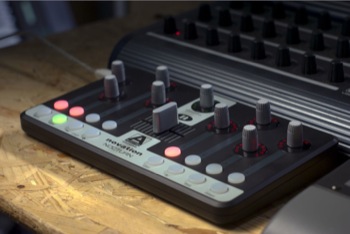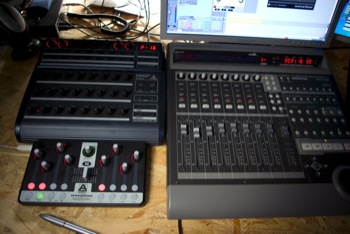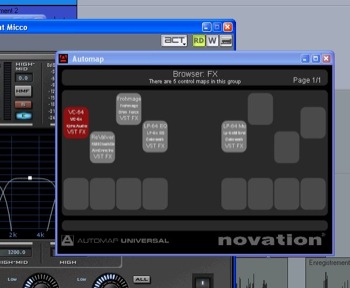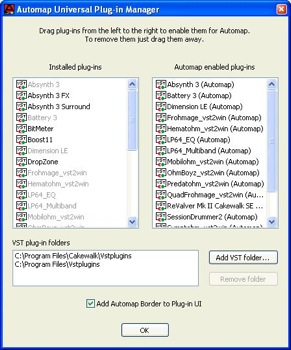Novation is well known for quality keyboards, MIDI controllers and synthesizers, whether it be hardware or software. Does Nocturn, the newest member of the Novation controller family, featuring the Automap system and a low price, live up to the brand’s reputation? Let’s take a look…
 |
Automap
In recent years, several developers have been working on coming up with systems that would spare the user from having to go through arduous settings when using their control surfaces. MIDI learn, now almost universal, was a first step, but some have tried to implement systems that detect software settings and automatically affect them to the controls of the controller. Several companies have developed solutions along this line, notably Cakewalk with ACT (Active Control Technology) included in Sonar and Project5, and Novation with its Automap. The idea is that when you activate a plug-in, its various parameters will automatically be assigned to various controls on your controller. Nocturn is based on this system but can also function as a classic MIDI controller.
The Device
The Nocturn is a small device that will take up little space in the often crowded environment of a home-studio. Moreover, its only connection is via USB, which is located on its left side (clever), to easily connect the device to another controller or keyboard. It’s relatively heavy for its small size, which seems to signify a certain robustness and gives it perfect stability, especially since its base has two large anti-slip pads. Once in place, it doesn’t budge. Its weight is equivalent to that of 5–6 CDS in their jewel cases, so it’s quite transportableThe base, which isn’t very thick, is a little thicker at the rear giving it a facade that’s slightly tilted towards the user. It includes:
-
16 rubber buttons with red or green LEDs
-
A cross fader with a track of around 6 centimeters wide
-
9 infinite rotary encoders (knobs) with LED surround
|
Though you don’t have to worry about damaging the rubber buttons, the other controls need to be protected when transporting the device. The Nocturn gives the strange impression of being, at the same time, a quality product and an entry-level device. On a positive note, it’s got a nice look to it, with a cool black surface, a very sober visual design, an elegant distribution of controls (this provides excellent readability) and LEDs whose brightness is well adjusted. Basically, it’s an attractive object.
On the negative side, there are the very cheap rotary knobs. Some seem quite loose. This can perhaps be explained by the fact that they are touch-sensitive though made of plastic. So I guess that the knob must be slightly loose to ensure contact, but it must be said that it feels a little cheap and it’s strange that they don’t all have the same looseness. Plus, one might worry about what the knobs will feel like after a long period of use. It is even worse with the crossfader which is quite loose.
Despite this, the overall impression of the device is largely positive.
In use
This good impression is reinforced while using the device. You then tend to forget the loose knobs except when trying to fine tune some settings. But it’s never really too annoying. Although the knobs are not detented (with the exception of the Speed Dial), a very slight notching is noticeable on some of them, which makes handling them a bit less pleasant (but this doesn’t affect the result). It’s all the more surprising that this is not the case for all of them. Here we see the consequences of the “lowest price”. In use, these infinite controllers are, despite all this, pleasant to use.
The crossfader is also very pleasant and smooth with just enough firmness. Let’s be clear: it seems obvious that there’s no way of using this device in a classic DJ situation. But it will be fine for occasionally mixing tunes amongst friends. In any case, a horizontal fader has many other uses, including control of virtual instruments and effects. All the better since Nocturn is mainly designed for that.
So, the impression of its hardware side is clearly positive. From a tactile standpoint as well as an esthetic one, the Nocturn is attractive and makes you want to play around with it.
Installation
The package includes the Nocturn, a USB cable, ads for Focusrite and Novation products, a 4-page Quick Start Guide and the installation CD. Surprise: my CD was … empty. Hopefully few people will be affected by this error, but it’s really not a problem: just go to their site to get the software and drivers. It would be a good idea to check their site out anyway: there are a number of short but well made video tutorials. As for the manual, it’s quite clear. Unfortunately, it seems to be behind a version, but nothing dramatic.
How does it work?
|
Usually, a controller communicates directly with software by exchanging MIDI information. With Automap, it adds software between the two. This brings many additional functions. The first is that it automatically recognizes the active software. For example, click on a plug-in for it to become controlled application. The settings associated with this application are also stored and recalled, without the need to change the preset or template on the controller.
The other advantage of Automap, as already mentioned above, is that it automatically maps the specific software controls to Nocturn’s controllers. But this “advantage” is theoretical since mapping seems to be random and, with of all the plug-ins that I tried, none were really usable or efficiently mapped by default. Therefore everything needs to be reassigned by hand, which is done easily and quickly thanks to its very fluid and extremely fast “learn” patterns. This is where the touch-sensitive knobs come into their own, because all you have to do is touch a knob for learn mode to assign to it the last used or highlighted control on the screen.
Actually, the thing that takes the longest time is thinking about how to assign the controls in the most logical and intuitive way possible, especially since the Nocturn doesn’t have a screen. Only the Automap window displays assignments. So there’s therefore one more window on the screen (usually already congested enough). Fortunately, this window can be displayed and masked via a very easy to see dedicated button on the Nocturn. You can choose transparency and it can also be resized, which includes reducing the displayed information: full, only controls, or only the selected control. Too bad it’s impossible to make this window “invisible” for the mouse. This would have made it possible to keep it in transparent mode on the screen as you work, without worry about it . Maybe they’ll resolve this in a future version of the software which Novation obviously plans to evolve. But in the end, all this is far from essential.
The Automap has, however, a significant issue: its official name is “Automap Universal.” This is misleading, because the Automap is still far from being “universal”.
Automap with Software
|
For software to be “Auto-mapped” first you must run the “Plug-in Manager” which will scan VST folders. But the “Universal” Automap applies only to plugins, and more specifically, to VST plug-ins. OK, that includes many plug-ins, but it excludes too many standalone versions, plug-ins in DX format (yes yes, there are still many of them) and probably a number of integrated plug-ins of sequencers (in Sonar Producer, the Sonitus Suite is not taken into account). I’m also thinking about smaller programs like Magix Studio or Music Maker or many others whose instruments may not be “Auto-mapped”. It’s a shame, because this small and inexpensive controller would have normally appealed to users of these types of software (which are even sometimes used by owners of more higher-level sequencers). Since we’re talking about sequencers, notice that you can control the mixing for the 4 market leaders Cubase, Sonar, Logic and Live (others coming from Novation). This control remains relatively limited, but covers the essentials. Thus, under Sonar, you can control volume, pan, mute, solo, record ready, auxiliary send activation, and send level. If you’re hoping to mix a big project with the Nocturn you’d better think again. The limit is about 6 or 8 tracks. Then you’re lost. But it’s not bad at all for those with no controller for mixing: the gain in comfort and efficiency is much greater than working with just a mouse. But it’s still not as efficient as a Behringer BCF in Mackie Control mode. Nocturn especially lacks a transport bar control.
But Nocturn really shines when it comes to controlling plug-ins. Whether it be synths or effects, it is very comfortable and fluid to use. It takes control of the active plug-in, but you can easily navigate through all the other controlled modules that you previously selected through dedicated buttons. The controlled elements are organized in banks (User, FX, Instruments and Mixer) each with its dedicated button and you can reorganize all this to your liking in a few clicks.
Conclusion
Even if the “Universal” Automap term is slightly misleading, we see that Nocturn still offers practical possibilities given its size and price. Above all, using it is pleasant and fun, … basically, everything you like when it comes to music. If you are well aware of its shortcomings, mainly its non-universality, it’s a purchase that is quite good for both the person without a controller and for someone well-equipped who’d like an additional controller that’s elegant and user-friendly, whether it be for a studio or mobile setup. It’s a success.
[+] Nice look
[+] Pleasant controls
[+] Easy installation and user-friendly
[+] Stability and efficiency
[+] Small
[+] Video tutorials on Novation’s site
[-] Automap not “universal”
[-] USB only (can only use with a computer)
[-] A few aspects that are a little cheap
[-] Necessitates another window on your screen




